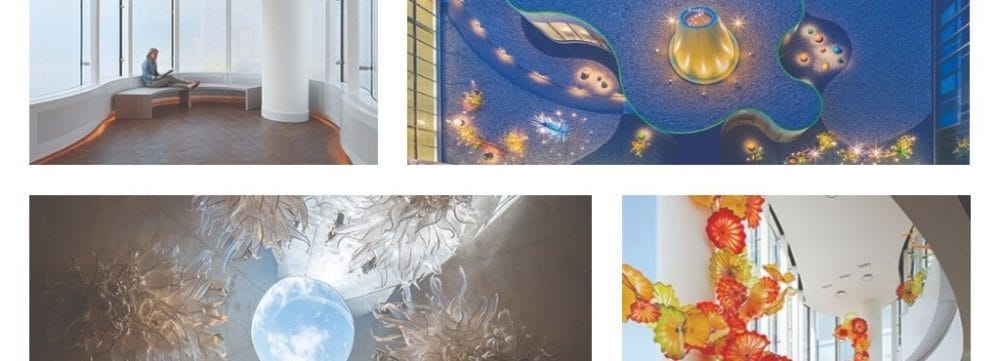Blog
The House of Glass – Holistic Healing & the Highest Level of Cancer Treatment

The Fred & Pamela Buffett Cancer Center in Omaha, Neb., is designed to be a place of holistic healing, providing the highest level of cancer care and treatment. But healing often requires more than just treating patients medically.
“Studies have shown that creating an atmosphere of hope and resilience through artwork goes beyond curing a disease and leads to improved patient outcomes,” says Dr. Kenneth Cowan, director of the $323 million project.
The facility is the product of a joint effort between Nebraska Medicine and the University of Nebraska Medical Center. It opened in June 2017 and comprises the Suzanne and Walter Scott Cancer Research Tower, C.L. Werner Cancer Hospital, and a multidisciplinary outpatient center.
Healing Arts Program
The project’s healing arts program was launched in 2014 during the planning and design stages, inspired by research on the medical benefits of art. The goal was to create an environment that supports and comforts patients and staff. Elements of the program include therapeutic art, music, and poetry programs for patients; diverse art collections; and Leslie’s Healing Garden, featuring heated pathways (for snow melt) that are wide enough to accommodate hospital beds.
The Program’s Cornerstone – Chihuly Sanctuary
The healing art program’s cornerstone is the 3,667-square-foot Chihuly Sanctuary, which was unveiled in May 2017, prior to the facility opening, and is home to more than 3,000 handblown glass elements by world-renowned glass artist Dale Chihuly.
The idea for the sanctuary was born during early conversations between Chihuly and Omaha philanthropist Walter Scott regarding the arts program. Chihuly Studio and HDR(Omaha, Neb.), which was the architect for the Buffett Cancer Center, collaborated on the two-story sanctuary, which is situated between the hospital and research tower.
Chihuly’s fascination with nature and flowers is evident throughout the space, beginning with its organic shape, which is modeled after his “Macchia” series of large, free-flowing glass vessels in brilliant colors. The building’s glass façade is accentuated by a delicate frit pattern with minute ceramic and glass particles fused to glass, suggestive of rain drops. The space overlooks Leslie’s Healing Garden, providing a connection between the flower-inspired art pieces inside the sanctuary and the natural environment found outside. The garden’s shape and pathways also mimic the form of the sanctuary.
The centerpiece is a large open cone called the Reflection Room, which is inspired by British glassmaking shops from the 1700s. An oculus in the ceiling is framed by crystal sconces and provides a view to the skies above, while the doors to the room are wide enough to accommodate a rolling hospital bed for patients who aren’t ambulatory.
Intimate niches and alcoves surround the cone, and benches are available so visitors can rest, meditate, pray, or simply admire the light playing off the artwork. Here, there is also ample room to navigate a wheelchair or hospital bed. A neutral palette of furnishings and finishes provides an unobtrusive backdrop to the more vibrant colors and forms.
Ten installations are on view both inside and outside, including a series of “Sunrise Persian Columns” in spaces overlooking the healing garden. A main attraction is an interior “Fiori” garden from Chihuly’s “Mille Fiori” series, which translates to “1,000 flowers” in Italian. An exterior rooftop “Mille Fiori” composition captures a sapphire “Icicle Tower,” multiple amethyst and cassel yellow “Fiori,” and large glass “Niijima Floats.”
Inspired by the idea of the sanctuary, Chihuly also created a new series, “Ikebana Glass-on-Glass” paintings that feature pictures of Japanese ikebana-style flower arrangements painted on three sheets of glass with enamel. The multi-paned artwork, on display in the drawing room, plays with light and density to highlight deep saturated color and detail and is illuminated by LEDs.
Chihuly selected two of his favorite colors to accent the sanctuary, with the roof line defined in a bright chartreuse inspired by the edge wraps from his “Macchia” series, while the exterior of the cone piece features a warm yellow tone. These defining colors of the Chihuly Sanctuary can be seen from many vantage points within the cancer center, signifying to everyone that there’s something unique and special here—a place where art and architecture have come together to help make a difference in the lives of patients, researchers, and caregivers.
Bruce Carpenter, AIA, is a senior vice president and principal-in-charge at HDR (Omaha, Neb.). He can be reached at bruce.carpenter@hdrinc.com.
Project details
Project name: Chihuly Sanctuary, Fred & Pamela Buffett Cancer Center
Completion date: May 2017
Owner: University of Nebraska Medical Center and Nebraska Medicine
Total building area: 3,667 sq. ft.
Total construction cost: N/A
Cost/sq. ft.: N/A
Architecture: HDR
Interior design: HDR
Contracting: Kiewit
Engineering: HDR
Construction: Kiewit
Art: Dale Chihuly, Chihuly Studios
Carpet/flooring: Oregon Lumber Co., Zongkers Custom Furniture and Cabinetry, Ceramiche Caesar, RBC Tile & Stone, Commercial Flooring Systems, Interface, Construction Specialties
Ceiling/wall systems and finishes: Fellert (ceilings), PPG Architectural Coating (paint), Armourcoat (Venetian plaster), Zongkers Custom Furniture and Cabinetry (custom wood panel cladding)
Furniture—seating/casegoods: Zongkers Custom Furniture and Cabinetry (custom wood benches), Forms & Surfaces (site furnishings)
Handrails/wall guards: Zongkers Custom Furniture and Cabinetry
Roof deck sidewalks: Daedalus Construction Co.
Understory planting/ground cover: Lanoha Nurseries
Source:
“House Of Glass: The Chihuly Sanctuary At The Fred & Pamela Buffett Cancer Center.” HCD Magazine, 15 Mar. 2018, www.healthcaredesignmagazine.com/projects/house-glass-chihuly-sanctuary-fred-pamela-buffett-cancer-center/#slide-3.







